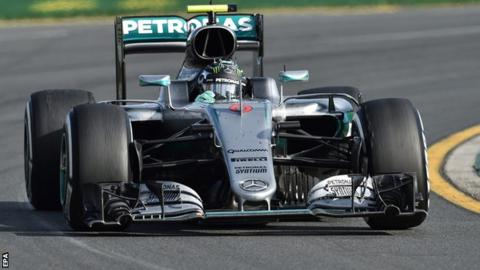
Mercedes’ Nico Rosberg won a dramatic Australian Grand Prix, after a huge crash for McLaren’s Fernando Alonso.
A bad start dropped Lewis Hamilton from pole to sixth but he fought to second.
Rosberg took advantage when the race was stopped following Alonso’s high-speed barrel-roll to switch strategy and overhaul early leader Ferrari’s Sebastian Vettel.
Vettel’s strategy gamble on super-soft tyres mid-race failed and he took third ahead of Red Bull’s Daniel Ricciardo.
A thrill-a-minute race, with action throughout the field, provided the start to the season for which F1’s bosses were hoping.
But its unpredictable nature meant it was impossible to form a definitive judgement on the exact relative competitiveness of the Mercedes and Ferrari teams who will dispute the season.
Massive accident changes outcome
The race arguably turned as a result of the terrifying accident involving Alonso and Esteban Gutierrez of new team Haas on lap 17.
Trying to pass the Mexican on the run down to Turn Three, Alonso’s front right wheel tagged the right rear of the Haas and he was launched into a barrel roll, coming to rest upside down in the barriers.
The two-time champion was clearly shaken but, although he limped away from his car, he was uninjured.
For the re-start, Ferrari chose to keep Vettel on the fast but fragile super-soft tyres he had fitted at his first pit stop, while Mercedes switched Rosberg from soft to medium tyres with the aim of going to the end without another stop.
From that moment on, the race was Rosberg’s barring problems. He merely had to hang on to Vettel and wait for the Ferrari to stop, which he did on lap 35.
What happened to Hamilton?
Hamilton had been in imperious form through practice and qualifying. He was out of the reach of his rivals as he re-found the form that had won him his third world title in 2015, but which he lost in the final three races of last season when he stopped working as hard once the title was won.
But the new rules restricting the use of driver aids at starts bit him when he made a poor getaway and was swamped by Rosberg and Vettel on the run to the first corner.
Hamilton’s life was made more difficult when Rosberg edged him out to the edge of the track and he lost three further places.
Hamilton soon passed Williams’ Felipe Massa, but Toro Rosso’s Max Verstappen was more difficult and Hamilton pleaded for a different strategy, Mercedes fitting medium tyres at his first pit stop on lap 16.
Mercedes were switching him to a one-stop strategy rather than the more common two in an attempt to make up more places.
He stayed on those tyres during the race stoppage and although he was seventh at the re-start, he moved up as drivers in front of him stopped.
Hamilton appeared set for a comfortable cruise to second place only to make a mistake with six laps to go.
That put Vettel, faster on fresher, softer tyres, on his tail but Hamilton was able to hold him off to the flag – a task eased when Vettel spun on to the grass at the penultimate corner with two laps to go.
Mercedes v Ferrari
The differing tyre strategies of the two leading teams made it hard to judge their relative pace.
Overall, though, it would seem Mercedes do have a pace advantage but Ferrari did enough to prove they may be close enough to be more of a thorn in their side than they were in 2015.
Impressive debuts
Finishing behind Ricciardo, Massa took fifth ahead of other Haas of Romain Grosjean – an impressive debut for the team.
Britain’s Jolyon Palmer was running in the points mid-race on his debut but was passed by the Toro Rosso cars and ended up 11th, one place ahead of team-mate Kevin Magnussen.
While Alonso had been running 10th before his crash, team-mate Jenson Button had a low-key race and took 14th.
Australian GP coverage details



